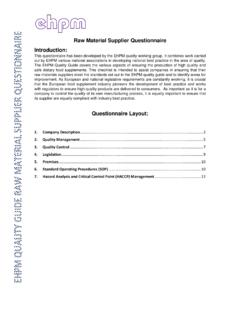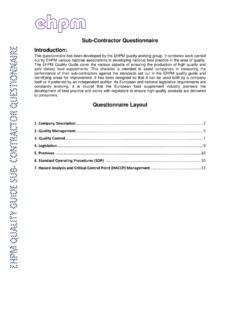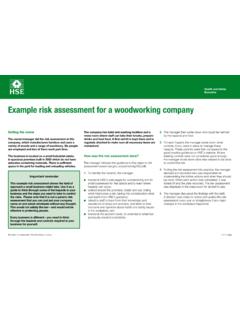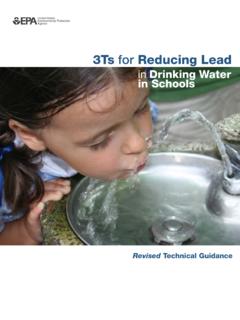Transcription of 7 Principles Sample Forms - LKC training
1 Docs/commercial services/ safe /haccp document and record Forms 1 HACCP Hazard Analysis and Critical Control Points 7 Principles & Sample Forms docs/commercial services/ safe /haccp document and record Forms 2 Application of the Principles of HACCP Principle 1 - Conduct a Hazard Analysis The application of this principle involves listing the steps in the process and identifying where significant hazards are likely to Occur. The HACCP team will focus on hazards that can be prevented, eliminated or controlled by the HACCP plan.
2 A justification for including or excluding the hazard is reported and possible control measures are identified. Principle 2 - Identify the Critical Control Points A critical control point (CCP) is a point, step or procedure at which control can be applied and a food safety hazard can be prevented, eliminated or reduced to acceptable levels. The HACCP team will use a CCP decision tree to help identify the critical control points in the process. A critical control point may control more that one food safety hazard or in some cases more than one CCP is needed to control a single hazard. The number of CCP's needed depends on the processing steps and the control needed to assure food safety.
3 Principle 3 - Establish Critical Limits A critical limit (CL) is the maximum and/or minimum value to which a biological, chemical, or physical parameter must be controlled at a CCP to prevent, eliminate, or reduce to an acceptable level the occurrence of a food safety hazard. The critical limit is usually a measure such as time, temperature, water activity (Aw), pH, weight, or some other measure that is based on scientific literature and/or regulatory standards. Principle 4- Monitor CCP The HACCP team will describe monitoring procedures for the measurement of the critical limit at each critical control point. Monitoring procedures should describe how the measurement will be taken, when the measurement is taken, who is responsible for the measurement and how frequently the measurement is taken during production.
4 Principle 5 - Establish Corrective Action Corrective actions are the procedures that are followed when a deviation in a critical limit occurs. The HACCP team will identify the steps that will be taken to prevent potentially hazardous food from entering the food chain and the steps that are needed to correct the process. This usually includes identification of the problems and the steps taken to assure that the problem will not occur again. Principle 6 - Verification Those activities, other than monitoring, that determine the validity of the HACCP plan and that the system is operating according to the plan. The HACCP team may identify activities such as auditing of CCP's, record review, prior shipment review, instrument calibration and product testing as part of the verification activities.
5 Principle 7 - Recordkeeping A key component of the HACCP plan is recording information that can be used to prove that the a food was produced safely. The records also need to include information about the HACCP plan. Record should include information on the HACCP Team, product description, flow diagrams, the hazard analysis, the CCP's identified, Critical Limits, Monitoring System, Corrective Actions, Recordkeeping Procedures, and Verification Procedures. HACCP Does not Stand Alone The application of HACCP does not stand alone in a food processing facility. The plan must be built on other food safety programs. Good Manufacturing Practices (GMP) that are practiced by the processing facility will support HACCP plan and will address food safety and food quality issues that are not critical for the reduction of food safety hazards.
6 Sanitation Standard Operating Procedures (SSOP's) are required in federally inspected meat and poultry operations and address procedures for clean facilities, equipment and personnel that are necessary for all products produced in a facility. docs/commercial services/ safe /haccp document and record Forms 3 HACCP DOCUMENTS AND RECORD Forms o Staff hygiene and work rules o Staff training record o Employee medical questionnaire o Staff sickness record o Cleaning schedule o Pest control monitoring record o Maintenance record log o Glass / crockery policy o Delivery temperature record o Cooking log o Storage temperature record o Cooking and cooling log o Calibration Record o Supplier Assessment Questionnaire docs/commercial services/ safe /haccp document and record Forms
7 4 HACCP STAFF HYGIENE AND WORK RULES 1. Avoid direct handling when preparing or serving cooked ready to eat products. 2. All staff must wear clean overalls and hats when handing food. Overalls and hats must not be worn outside the premises, except when involved with delivery. 3. Staff must not wear watches or jewellery, except a plain band wedding ring and small sleeper earrings. 4. Staff must not wear strong perfume or aftershave. 5. Food and drink must not be consumed in the food preparation areas. 6. Smoking in a food room is prohibited. 7. Hands must be washed thoroughly with soap and water:- Before starting work After breaks After visiting the toilet or on return to the workplace After coughing into the hand or using a handkerchief Before handing cooked meat After eating, drinking or smoking After touching face or hair After carrying out any cleaning 8.
8 Staff must not lick fingers when handling wrapping materials. 9. Staff must not blow their nose, cough or sneeze over food. 10. Hair and fingernails must be kept clean. Nail varnish must not be worn. 11. Staff must inform the manager if they are suffering from vomiting, diarrhoea, other stomach upsets, skin complaints or cuts. Cuts and abrasions must be covered by an easily detectable waterproof dressing blue in colour. 12. Staff must ensure that raw food does not come into contact with cooked / ready to eat food. 13. Staff must not use the same equipment or working surfaces for raw and cooked ready to eat foods without thoroughly cleaning and disinfecting them first.
9 14. Staff must protect food at all times from contamination. 15. Keep food containers off the floor. I have read the Staff Hygiene and Work Rules and agree to abide by them. Signed: .. Date: .. Print Name: .. docs/commercial services/ safe /haccp document and record Forms 5 HACCP STAFF training RECORD STAFF NAME DATE STARTED PREVIOUS training UNDERTAKEN training PERFORMED DATE PERFORMED SIGNED BY EMPLOYEE SIGNED BY MANAGER docs/commercial services/ safe /haccp document and record Forms 6 HACCP EMPLOYEE MEDICAL QUESTIONNAIRE NAME.
10 ADDRESS: .. OCCUPATION: .. 1. Have you ever had or been a carrier of:- o A food borne disease Yes No o Typhoid or paratyphoid Yes No o Tuberculosis Yes No o Parasitic infections Yes No 2. Has any close family contact suffered from any of the above? Yes No 3. At present are you suffering from any of the following:- o Diarrhoea or vomiting Yes No o Skin trouble Yes No o Boils, styes or septic fingers Yes No o Discharge from the ears, eyes, gums or mouth Yes No 4. Please give details of any other medical problems which may affect your employment as a food handler, for example recurring gastrointestinal disorder.




